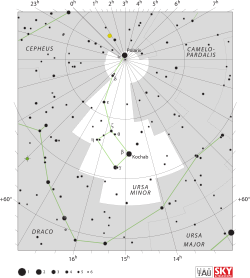Epsilon Ursae Minoris
| Epsilon Ursae Minoris (ε) | |
 | |
| Observationsdata Epok: J2000 | |
|---|---|
| Stjärnbild | Lilla björnen |
| Rektascension | 16t 45m 58,2s[1] |
| Deklination | +82° 02′ 14,1″[1] |
| Skenbar magnitud () | +3,05[2] |
| Stjärntyp | |
| Spektraltyp | G5 III[3] |
| U–B | +0,55[4] |
| B–V | +0,89[4] |
| Variabeltyp | Förmörkelsevariabel[2] och eruptiv variabel av RS Canum Venaticorum-typ(RS)[5] |
| Astrometri | |
| Radialhastighet () | -10,57 ± 0,40[6] km/s |
| Egenrörelse (µ) | RA: +19,47[7] mas/år Dek.: +2,61[7] mas/år |
| Parallax () | 10,73 ± 0,39[7] |
| Avstånd | 300 ± 10 lå (93 ± 3 pc) |
| Absolut magnitud () | -0,922[8] |
| Detaljer | |
| Massa | ± 0,3[6] M☉ |
| Radie | 16,23[9] R☉ |
| Luminositet | 197,80[9] L☉ |
| Temperatur | 5 074[9] K |
| Metallicitet | -0,25 ± 0,04[3] |
| Vinkelhastighet | 25,6[3] km/s |
| Andra beteckningar | |
| 22 Ursae Minoris, GCRV 9717, PLX 3864, SKY# 30193, GEN# +1.00153751, PLX 3864.00, TD1 19820, 22 UMi, GSC 04580-01154, PMC 90-93 645, TYC 4580-1154-1, ADS 10242 A, HD 153751, PPM 2925, UBV 21588, AG+82 491, HIC 82080, RBS 1605, uvby98 100153751 V, BD+82 498, HIP 82080, ROT 2401, WDS J16460+8202A, CABS 137, HR 6322, RX J1645.8+8202, B10 4327, CCABS 110, IDS 16562+8212, RX J1645.9+8202, HFE83 1207, CCDM J16460+8203A, IRAS 16510+8207, 1RXS J164558.1+820214, ZEH2003 RX J1645.9+8202 1, CSI+82 498 1, JP11 2806, SAO 2770, FK5 912, 2MASS J16455813+8202141, SBC7 605, GC 22749, N30 3770, SBC9 940[1] | |
Epsilon Ursae Minoris (ε Ursae Minoris, förkortat Epsilon UMi, ε UMi) som är stjärnans Bayer-beteckning, är en trippelstjärna[10] i den norra delen av stjärnbilden Lilla björnen. Den har en kombinerad skenbar magnitud på +4,19[2] och är synlig för blotta ögat där ljusföroreningar ej förekommer. Baserat på parallaxmätningar i Hipparcos-uppdraget på 10,7[7] mas beräknas den befinna sig på ca 300 ljusårs (93 parsek) avstånd från solen.
Egenskaper
Primärstjärnan av Epsilon Ursae Minoris är en gul till vit jättestjärna av spektralklass G5 III.[3] Den har en radie som är ca 16[9] gånger större än solens och utsänder ca 200[9] gånger mera energi än solen från dess fotosfär vid en effektiv temperatur på ca 5 100 K.[9]
Konstellationen bildar en fristående[5] enkelsidig spektroskopisk dubbelstjärna[3] med en omloppsperiod på 39,5 dygn och en liten excentricitet av 0,04.[11] Omloppsplanet är nästan i linje med siktlinjen från jorden, så paret bildar en förmörkande dubbelstjärna. Primärstjärnans förmörkelsen har lägst 4,23 i magnitud, medan följeslagarens minimum är 4,21.[2] Den närmaste följeslagaren, Epsilon Ursae Minoris A kretsar så nära huvudstjärnan att man bara kan se den på spektroskopisk väg medan den andra, Epsilon Ursae Minoris B av magnitud 12,32, kretsar 77 bågsekunder från huvudstjärnan vid en positionsvinkel på 2°.[12]
Se även
Referenser
- Den här artikeln är helt eller delvis baserad på material från engelskspråkiga Wikipedia, Epsilon Ursae Minoris, 20 april 2019.
Noter
- ^ [a b c] ”Basic data: * eps UMi -- Variable of RS CVn type” (på engelska). Centre de Données astronomiques de Strasbourg. http://simbad.u-strasbg.fr/simbad/sim-basic?Ident=Epsilon+Ursae+Minoris&submit=SIMBAD+search. Läst 9 juli 2015.
- ^ [a b c d] Avvakumova, E. A.; et al. (October 2013), "Eclipsing variables: Catalogue and classification", Astronomische Nachrichten, 334 (8): 860, Bibcode:2013AN....334..860A, doi:10.1002/asna.201311942
- ^ [a b c d e] Strassmeier, K. G.; et al. (October 2012), "Rotation, activity, and lithium abundance in cool binary stars", Astronomische Nachrichten, 333 (8): 663, arXiv:1208.3741, Bibcode:2012AN....333..663S, doi:10.1002/asna.201211719.
- ^ [a b] Nicolet, B. (1978), "Photoelectric photometric Catalogue of homogeneous measurements in the UBV System", Astronomy and Astrophysics Supplement Series, 34: 1–49, Bibcode:1978A&AS...34....1N.
- ^ [a b] Redfield, S.; et al. (June 2006), "A Cycle-4 Survey of RS CVn Binary Systems", in Sonneborn, G.; Moos, H.; Andersson, B.-G. (eds.), Astrophysics in the Far Ultraviolet: Five Years of Discovery with FUSE ASP Conference Series, Vol. 348, Proceedings of the Conference held 2-6 August, 2004 in Victoria, British Columbia, Canada, p. 269, Bibcode:2006ASPC..348..269R.
- ^ [a b] Karataş, Y.; Bilir, S.; Eker, Z.; Demircan, O. (2004), "Kinematics of chromospherically active binaries and evidence of an orbital period decrease in binary evolution", Monthly Notices of the Royal Astronomical Society, 349 (3): 1069, arXiv:astro-ph/0404219, Bibcode:2004MNRAS.349.1069K, doi:10.1111/j.1365-2966.2004.07588.x.
- ^ [a b c d] van Leeuwen, F. (2007), "Validation of the new Hipparcos reduction", Astronomy and Astrophysics, 474 (2): 653–664, arXiv:0708.1752, Bibcode:2007A&A...474..653V, doi:10.1051/0004-6361:20078357.
- ^ Böhm-Vitense, Erika; et al. (December 2000), "Ultraviolet Emission Lines in BA and Non-BA Giants", The Astrophysical Journal, 545 (2): 992–999, Bibcode:2000ApJ...545..992B, doi:10.1086/317850.
- ^ [a b c d e f] https://en.wikipedia.org/wiki/epsilonursaeminoris. Hämtad 3019-04-20.
- ^ Eggleton, P. P.; Tokovinin, A. A. (September 2008), "A catalogue of multiplicity among bright stellar systems", Monthly Notices of the Royal Astronomical Society, 389 (2): 869–879, arXiv:0806.2878, Bibcode:2008MNRAS.389..869E, doi:10.1111/j.1365-2966.2008.13596.x.
- ^ Pourbaix, D.; et al. (2004), "SB9: The Ninth Catalogue of Spectroscopic Binary Orbits", Astronomy & Astrophysics, 424: 727–732, arXiv:astro-ph/0406573, Bibcode:2009yCat....102020P, doi:10.1051/0004-6361:20041213.
- ^ Mason, B. D.; et al. (2008), Washington Visual Double Star Catalog, 2006.5 (WDS), U. S. Naval Observatory, Washington D.C., hämtad 2017-09-15.
Externa länkar
| |||||||||||||||||||
Media som används på denna webbplats
Författare/Upphovsman: IAU and Sky & Telescope magazine (Roger Sinnott & Rick Fienberg), Licens: CC BY 3.0
IAU Ursa Minor chart


